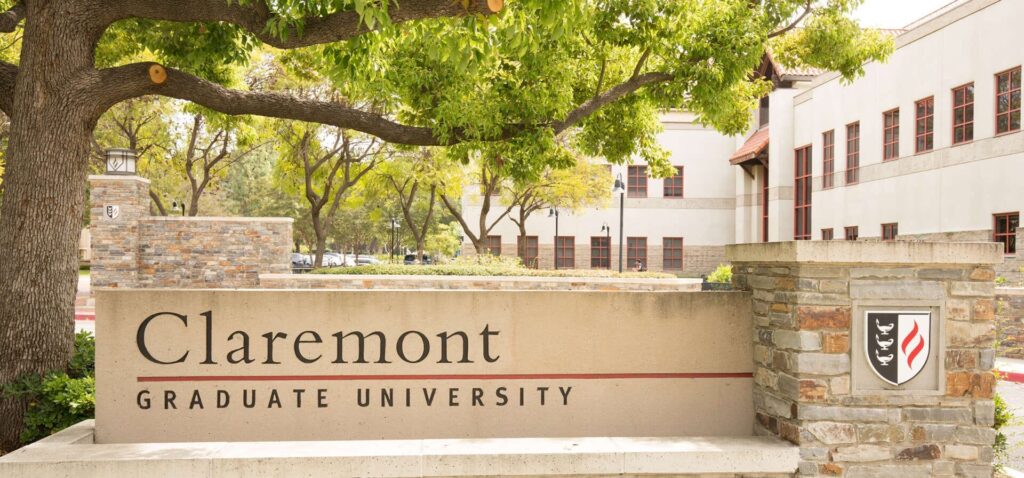dA exhibit celebrates Pomona’s rock ‘n’ roll heyday

Pomona College Associate Professor of History Tomás Summers Sandoval curated the dA Center for the Arts exhibit, “Sounds of Pomona: The Golden Era of Music 1955-1975,” which opens Saturday, November 11. Courier photo/Andrew Alonzo
by Andrew Alonzo | aalonzo@claremont-courier.com
Pomona’s dA Center for the Arts will take the phrase “getting the band back together” to a whole new level Saturday, November 11, when it opens “Sounds of Pomona: The Golden Era of Music 1955-1975,” with a free and open to the public 6 to 9 p.m. reception during the Pomona Art Walk.
Longtime residents of Pomona, musicians, and music lovers are going to want to drop by the dA, at 252 S. Main St., to see old school memorabilia, artwork, concert posters, records, clothing, and other items spotlighting bands such as Velveteens, the Sir Guys, the Pace Setters, and many more.
In addition to preserving this specific period of history, another goal of the exhibit was to create a learning space for today’s youth, according its curator, Pomona College Associate Professor of History Tomás Summers Sandoval.
“A big part of the exhibit is really … to get young people — who are alive now, who’re listening to music now, who’re living in Pomona, Pomona Valley or San Gabriel Valley, or Inland Empire now — to get them to learn a little bit about this history and to think broadly like all of us about what the role of music is in our lives,” he said. “If we don’t take responsibly for recording and preserving our own histories, no one else is.”
The idea came over a year ago from dA board members and community partners from the Pomona Music Project. Summers Sandoval then came on board as oral historian and curator, and he and dA leadership and others have worked to secure exhibition materials, oral interviews with band members and residents, and to set up the installation. Students from Summers Sandoval’s oral history course last fall were also enlisted to aid in gathering interviews for the exhibit.
Nestled on the eastern outskirts of Los Angeles County, both Pomona’s population and its music scene flourished from the 1950s through the ‘70s, Summers Sandoval said. From backyard parties, weddings, quinceañeras, and school dances, to stages at the Rainbow Gardens and Sacred Heart Hall, musicians were never short on venues.
“A lot of the folks that we interviewed, they’re in their first band when they’re 13, 14 — like they’re in middle school,” Summers Sandoval said. “Every Friday night, every Saturday night, there were places all throughout the southland that were about local bands playing R&B, rock ‘n’ roll music for teenagers to dance to.
“There’s always been a longer history of some of these things here than in other places. And that history doesn’t stop in the seventies, you know it just continues on. I mean today we have the Glass House, the Fox Theater that was once a movie [theater]. It’s definitely a story that continues on and it’s shifted and changed. I think the story that we’re telling in here, is about the music, but it’s really much more than that.”
Music created during this time revolved around the universal theme of love, he added. “Most rhythm and blues music, most rock ‘n’ roll music of this era is no different, it is love music,”
The installation is almost like a coming-of-age story for Black and Hispanic baby boomers of the area who grew up in trying times that included the Cold War, Vietnam War, and polarizing politics, Summers Sandoval said. Music was an outlet for the pent-up emotions of teenagers, with well-made instruments and lessons easily obtainable, and a culture bursting with like-minded potential bandmates.
“This is a generation that’s born with rock ‘n’ roll, and rock ‘n’ roll is their identity marker. It’s the sound of their generation,” Summers Sandoval said. “It’s this really interesting period where music is sort of supported and popular, so people are making their own bands. That part, the proliferation of local bands where young people hear something on the radio or see The Beatles on Ed Sullivan [in 1964] and then the next week are trying to find other friends to make a band with, that feels pretty unique to this time.”
Chronologically, the exhibit begins with the golden era of rock n’ roll and concludes with the pressures that led to the breakups of many local bands.
“A lot of them are broken up because of the Vietnam draft,” Summers Sandoval said. “But despite all that, music and the community that they built are these moments of joy, their expressions of joy. We’re hoping as we’re open for these three months for people to come down and also want to share their story. We’re going to have times there where me and others will be recording oral histories.”
The free exhibit runs through February 24, 2024, and will feature panel discussions with bands, performances, and dance nights over the next three months. The dA is open from 1 to 5 p.m. Tuesday through Saturday and 1 p.m. to 4 p.m. Sundays. More information is at dacenter.org.
“I mean if you walk into that place and walk out of that place without a smile on your face, we did something wrong,” Summers Sandoval said.










0 Comments